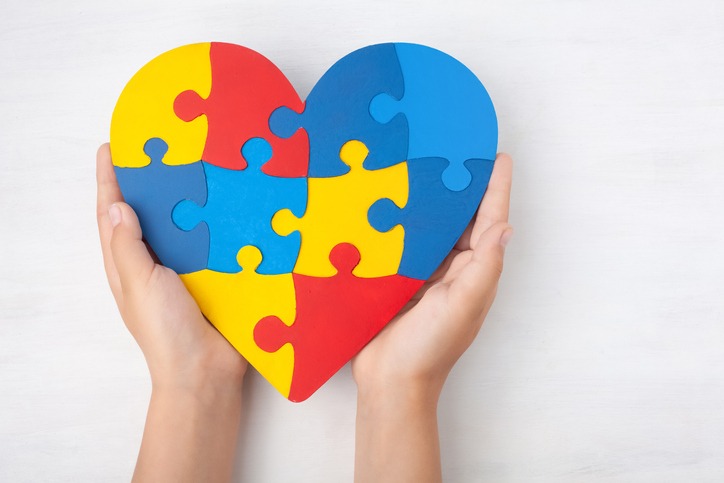
“Autism” is a term with which many people are familiar. Autism impacts many families, either in their own family, or through a relative or a friend. However, many people still struggle to understand what it means, how to identify it, and how to help. To make matters more confusing, autism is called many different things, and these terms change over time. This article clarifies these terms, and also offers information to help.
What does “Autism Spectrum” mean?
“Autism Spectrum” is a group of complex developmental brain disorders. Children on the Autism Spectrum oftentimes have delays in language, behavioral rigidity (also known as stereotyped interests), social interactions, and sensory concerns. Some children have concerns in all of these areas, and are often identified as having “autism.” Some children have concerns in 2-3 of these areas or have milder symptoms in all of the above areas. These children are identified as belonging on the “autism spectrum.” In the past, people also used terms like “Aspergers,” or “Atypical Autism” to describe children who are on the “autism spectrum.”
Children with autism spectrum concerns often have other concerns that also intersect with the autism symptoms listed above. They may also struggle with attention concerns, overactivity, and impulsivity. Many children have behavioral issues, such as tantrums and defiance, particularly when there are sensory or language concerns. Additionally, some children on the autism spectrum have rich vocabularies, but struggle in their ability to talk to others socially, or for practical purposes. At times, there are cognitive delays or learning issues. In addition, anxiety and depression issues are also common in children with autism spectrum, particularly if they are not receiving the support or services that they require to function well. Other concerns that are present with autism spectrum include genetic concerns, seizures, GI concerns, food allergies/intolerances, and sleep concerns. Many children with autism spectrum disorders have sensory processing disorders and eating concerns (often due to textures or food sensitivity).
Autism Spectrum Disorders are common
According to Autism Speaks, one in every 88 children is diagnosed with autism in the United States, making it more common than childhood cancer, juvenile diabetes and pediatric AIDS combined. Current estimates are that in the United States alone, one out of 54 boys is diagnosed with autism. The rates of diagnosis are increasing every year. One explanation for this increase is an improved understanding and awareness of autism spectrum by parents, schools, and clinicians.
Diagnosis of Autism Spectrum
A diagnosis of Autism spectrum is based on observed behavior, educational assessment, parent information, school feedback, and neuropsychological testing. Because symptoms of autism vary, so do the paths to obtaining a diagnosis. Often, parents have concerns, and bring up these concerns to their pediatrician and/or their child’s school. Unfortunately, professionals do not always understand or validate parents with these concerns. However, if a parent has lingering worries about autism, it is important to have your child evaluated. We know that children with autism who identified as early as possible often have the best outcomes. A Child Psychologist, Developmental Pediatrician, Pediatric Neurologist, or a Child Psychiatrist diagnose Autism Spectrum Disorders.
What Causes Autism?
Contrary to myth, willfulness, bad parenting, or vaccines do not cause autism spectrum concerns. There are many different causes. These causes are often related to a combination of genetics and environment. Some of the environmental factors include prenatal infections or drug exposure. There is some preliminary research which also suggests that autism may be related to difficulties with the child’s immune system and/or inflammation in the central nervous system. Bottomline, autism is complicated.
How Do I Help My Child with Autism Spectrum?
Be kind to yourself and allow yourself time to grieve and process. Many parents find themselves shocked, scared, and/or overwhelmed when their child is first diagnosed. This is normal, and a part of the process. Give yourself some time and reach out for help or support for yourself as well.
Talk to the provider who diagnosed your child and talk about a plan to move forward. Treatment includes many different parts (see below).
Components of a Treatment Plan for Autism Spectrum May Include:
Behavior Therapy
Children diagnosed with an autism spectrum disorder benefit from evidence-based, skills training. Therapy should involve parents as well. “Applied Behavioral Analysis” is a type of evidence-based behavioral therapy. Other treatments with evidence-based which can be helpful include: Project ImPACT, Parent Child Interaction Training, and Social Skills Training.
Medication
Many parents find that their children benefit from a trial of medication to help manage some of their child’s symptoms and/or concerns. A specialist, like a Child Psychiatrist, Pediatric Neurologist, or Developmental Pediatricians are the best suited to help under these circumstances.
Speech Therapy
Speech therapy can be helpful to address difficulties with social language, expressive language, or other communication concerns that can occur. Some speech therapists also help with academic issues, such as reading concerns.
Occupational Therapy
Occupational Therapy (OT) can teach parents and children ways to manage sensory integration concerns and self-calming. OT also can help with fine motor delays and weakness. Sometimes, OT can also help with life skills and adaptive functioning.
Special Education Support at School
Many children with an autism spectrum disorder benefit from accommodations or educational support within the classroom. They may also benefit from peer support and mentoring or paraprofessional assistance.
Physical Therapy (PT)
PT targets problems with movement. Children with autism frequently have challenges with motor skills such as sitting, walking, running or jumping. PT can address poor muscle tone, balance and coordination.
Dietician
A dietician can be very helpful in dealing with food intolerance plans, picky eating, and other concerns that can arise related to food and eating.
To Summarize
In summary, autism and autism spectrum disorders are complex, with many different origins and symptoms. Likewise, treatment can be equally complex. As a parent, it will be important to be kind to yourself, take one step at a time, and secure good support for yourself. All efforts help and make a difference for your child.
At Hope Springs, we evaluate and provide behavioral treatments for Autism and Autism Spectrum Disorders. We are here to help.
![]()
